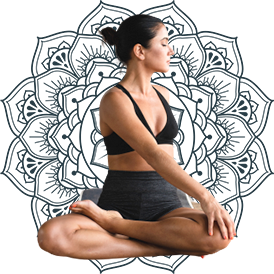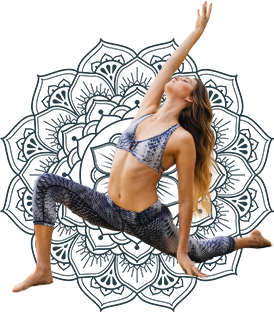Yoga FAQs Made Simple
Frequently Asked Questions about Yoga
Absolutely! Flexibility isn’t a prerequisite for yoga. It develops gradually with patience and practice. Each body is unique, and yoga is about embracing your current state and evolving from there.
Feeling a bit nervous about trying something new is completely normal. Rest assured, we’re a warm and welcoming group with a diverse mix of ages and abilities. You’ll be greeted with open arms!
Yes, they are! My classes cater to all levels, with modifications available to suit everyone. Whether you’re a novice or seasoned practitioner, you’ll find the practice accessible and enriching.
Classes generally include:
- A brief settling in with a breathing exercise or mini meditation.
- Easing out upper body stiffness and tension.
- Caring for the lower body (increasing strength and flexibility).
- A warm-up flowing routine involving stretches and functional movements.
- Holding postures.
- A winding-down stretch and, yoga breathing in Savasana.
- Yoga Nidra, deep relaxation, a crucial part of our practice.
- The session ends with a brief, teaching from the Yogic tradition and the chant of Om.
If your doctor or consultant has cleared you for exercise, you’re welcome to practise. Inform me about your injury beforehand so I can offer suitable modifications. Always listen to your body and avoid pushing beyond your limits.
There’s no such thing as being “good” at yoga. Yoga is about connecting with your body and mind, not about achieving perfection. We’re all on our own journeys, learning, exploring, and sometimes wobbling together.
Not at all! Just wear something comfortable that allows you to move freely.
While drop-ins are welcome, pre-booking through the website is recommended and more cost-effective. Drop-in rates are higher than pre-booked sessions.
You can still join if you’re only a little late. Enter quietly, unroll your mat at the back, and be mindful of others. Ideally, aim to arrive 5–10 minutes early to settle in.
Life happens! If you need to cancel, you can arrange to make up your missed class by joining a later session within a month.
Most people bring their own mats, but I have a few spares available if needed.
A reusable water bottle and a cosy blanket for relaxation are great to have. Layers are helpful for when you warm up or cool down, and extra knee support can be useful if needed.
The word yoga means unity, to yoke together, to connect.
Yoga is one of the world’s oldest systems of self-healing, originating in India thousands of years ago. It strengthens the body and calms the mind, aiming to still the mind for peace and harmony. Various types of yoga practices exist, all focusing on present-moment awareness (Samadhi).
Hatha Yoga focuses on breathing and posture work, releasing tension, boosting energy, and improving physical and mental health. It includes physical exercises, breathing techniques, and relaxation methods.
Hatha Yoga can be practised by anyone, regardless of age or physical ability. It features gentle poses, breathing exercises, and relaxation techniques that benefit everyone.
Yes, we advise consulting your doctor before attending. Pregnant students are welcome in any of our all-levels classes, as these sessions can be easily adapted to accommodate mums-to-be.
Regular practice of Hatha Yoga can significantly enhance your overall well-being, relieve pain, and reduce insomnia. Yoga not only improves flexibility, strength, and balance but also reduces stress, sharpens mental clarity, and promotes a sense of overall wellness..
For anyone interested in diving deeper into the history and philosophy of yoga, here’s a curated list of must-read books:
- Bhagavad Gita – A profound spiritual text that is a cornerstone of yoga philosophy.
- Yoga Sutras of Patanjali – Essential aphorisms on the philosophy and practice of yoga.
- The Upanishads – Ancient scriptures that delve into the spiritual teachings of yoga.
- Light on Yoga by B.K.S. Iyengar – A comprehensive guide to yoga postures and breathing techniques.
- Autobiography of a Yogi by Paramahansa Yogananda – An inspiring account of a yogi’s journey and spiritual experiences.
- Hatha Yoga Pradipika by Swami Satyananda Saraswati – A classical text on Hatha Yoga, covering postures, breathing, and meditation.
- Roots of Yoga by Mark Singleton and James Mallinson – A detailed exploration of the diverse traditions and texts that have shaped yoga.
- Breath: The Essence of Yoga by Sandra Sabatini – A guide to understanding the importance of breath in yoga practice.
- The Art of Adjusting by Brian Cooper – Techniques and insights for safely and effectively adjusting yoga postures.
- Yoga Body by Mark Singleton – An exploration of the modern history of yoga as a physical practice.
- Asana Pranayama Mudra Bandha by Swami Satyananda Saraswati – Comprehensive instructions on various yoga practices.
- The Heart of Meditation by the Dalai Lama – Insights into the practice of meditation from a spiritual leader.
- Yoni Shakti by Uma Dinsmore-Tuli – A celebration of the practice of yoga for women’s health and well-being.
- The Body Keeps the Score by Bessel van der Kolk – A book on how trauma impacts the body and mind, and how yoga can aid in healing.
- Yoga Sequencing by Mark Stephens – A practical guide to creating and teaching yoga classes.
Feel free to email me at jem@omasana.co.uk. I’d love to hear from you!







